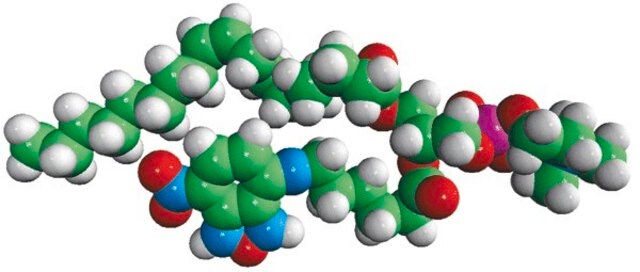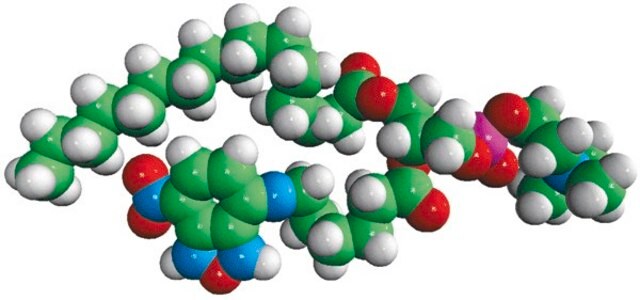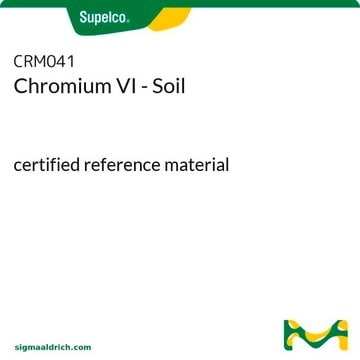810133C
Avanti
18:1-12:0 NBD PC
Avanti Research™ - A Croda Brand 810133C
Sinônimo(s):
1-Oleoyl-2-[12-[(7-nitro-2-1,3-benzoxadiazol-4-yl)amino]dodecanoyl]-sn-Glycero-3-Phosphocholine
About This Item
Produtos recomendados
Ensaio
>99% (TLC)
forma
liquid
embalagem
pkg of 1 × 1 mL (810133C-1mg)
pkg of 5 × 1 mL (810133C-5mg)
fabricante/nome comercial
Avanti Research™ - A Croda Brand 810133C
concentração
1 mg/mL (810133C-1mg)
1 mg/mL (810133C-5mg)
tipo de lipídio
fluorescent lipids
phospholipids
Condições de expedição
dry ice
temperatura de armazenamento
−20°C
Descrição geral
Aplicação
- the generation giant unilamellar vesicles (GUVs) subjected to fluorescence microscopy
- labelling lipid bilayers formed by vesicle fusion in order to study the lipid distribution by fluorescence microscopy
- the preparation of phospholipid-coated beads
Ações bioquímicas/fisiológicas
Embalagem
Informações legais
Palavra indicadora
Danger
Frases de perigo
Declarações de precaução
Classificações de perigo
Acute Tox. 3 Inhalation - Acute Tox. 4 Oral - Aquatic Chronic 3 - Carc. 2 - Eye Irrit. 2 - Repr. 2 - Skin Irrit. 2 - STOT RE 1 - STOT SE 3
Órgãos-alvo
Central nervous system, Liver,Kidney
Classe de risco de água (WGK)
WGK 3
Certificados de análise (COA)
Busque Certificados de análise (COA) digitando o Número do Lote do produto. Os números de lote e remessa podem ser encontrados no rótulo de um produto após a palavra “Lot” ou “Batch”.
Já possui este produto?
Encontre a documentação dos produtos que você adquiriu recentemente na biblioteca de documentos.
Nossa equipe de cientistas tem experiência em todas as áreas de pesquisa, incluindo Life Sciences, ciência de materiais, síntese química, cromatografia, química analítica e muitas outras.
Entre em contato com a assistência técnica










